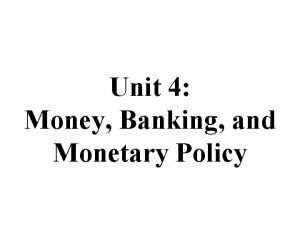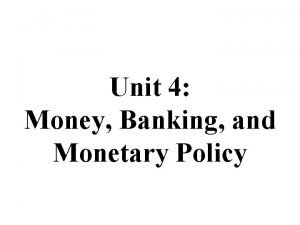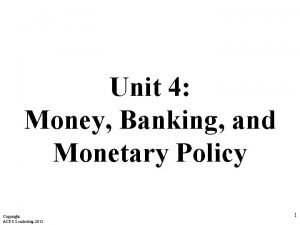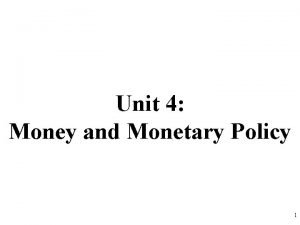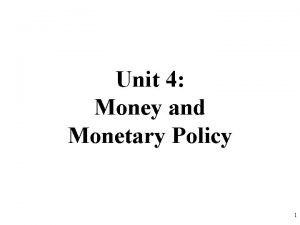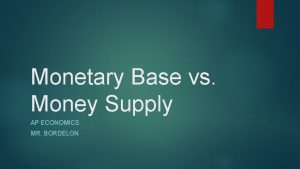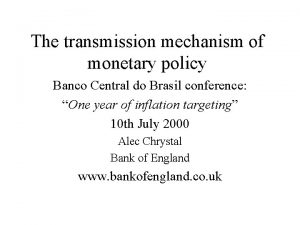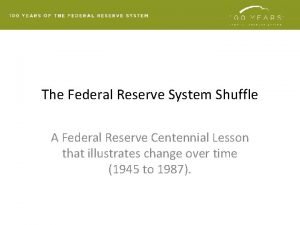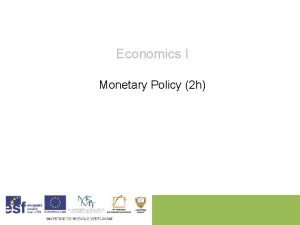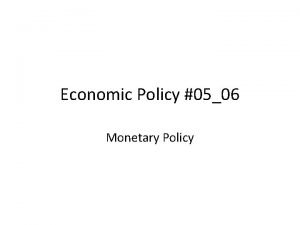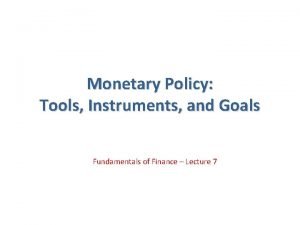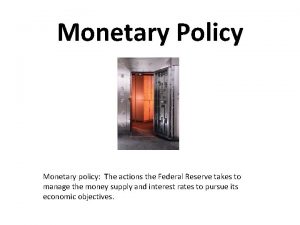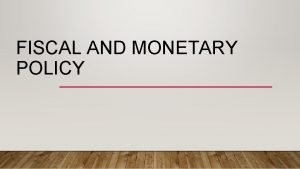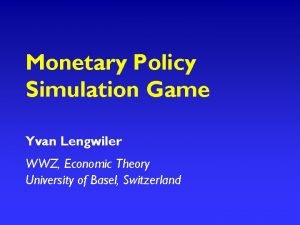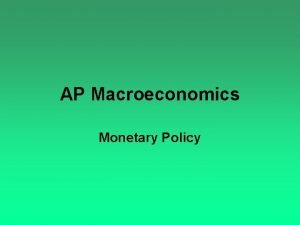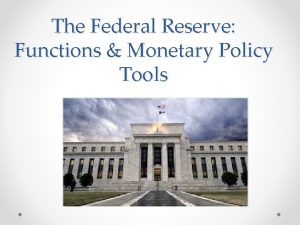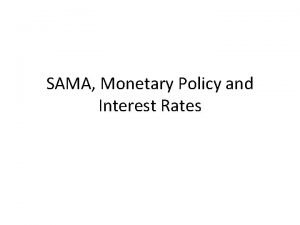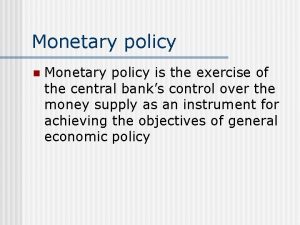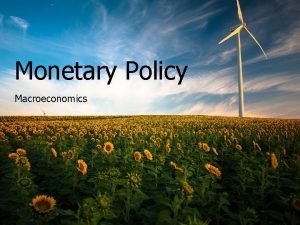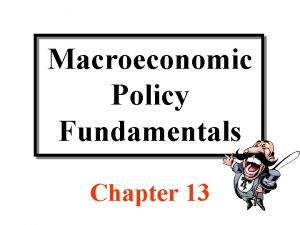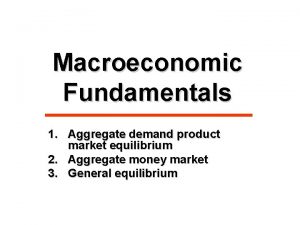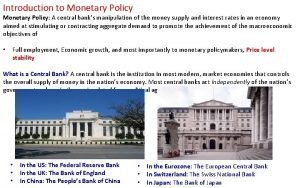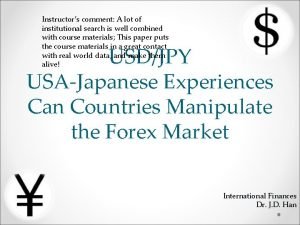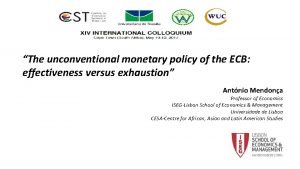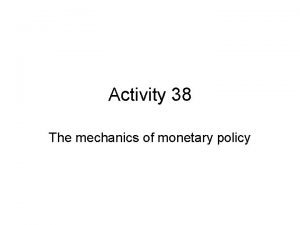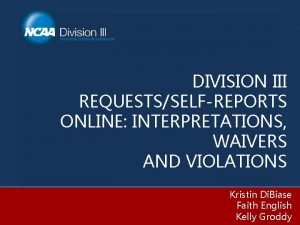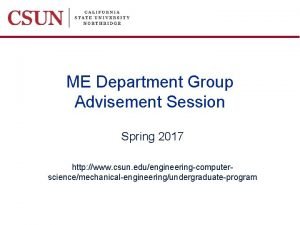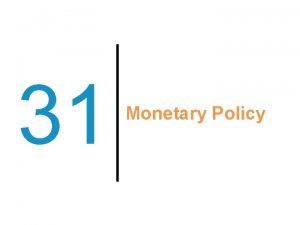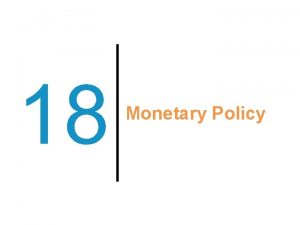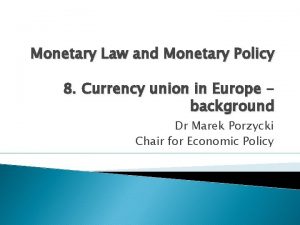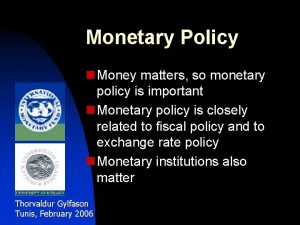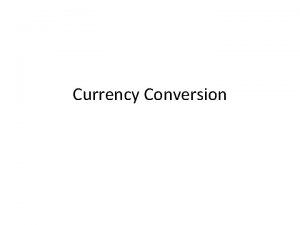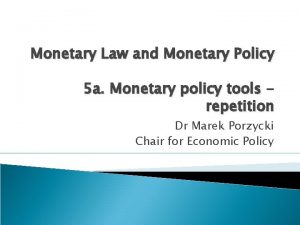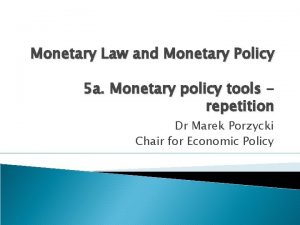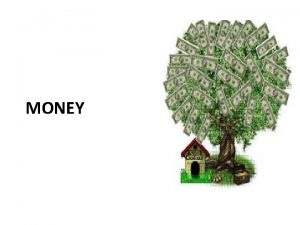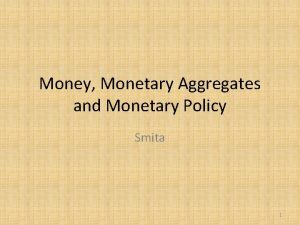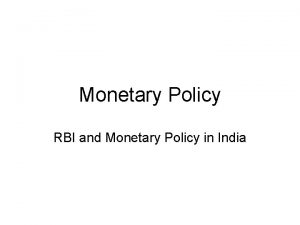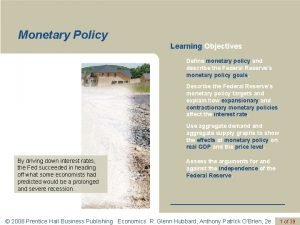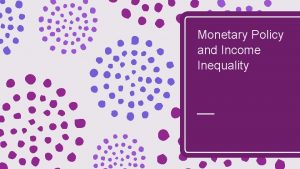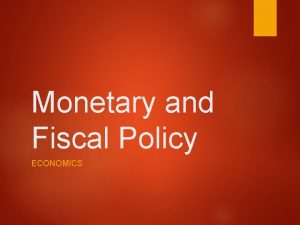31 Monetary Policy Previously Money includes currency and









































- Slides: 41

31 Monetary Policy

Previously • Money includes currency and bank deposits. • Banks can expand the money supply – By extending loans – Even though banks do not mint currency • The Fed’s job of monitoring the money supply is difficult. – Actions taken may be offset by the actions of banks, and even by the actions of individuals

Big Questions 1. What is the effect of monetary policy in the short run? 2. Why doesn’t monetary policy always work? 3. What is the Phillips curve?

Short Run vs. Long Run— 1 • Short run – Some prices are inflexible and do not adjust. • For example, wages and other resource prices are often set by contract and don’t change immediately • Long run – A period of time long enough for all prices to adjust

Expansionary Monetary Policy • Review of previous topics that will be used in this chapter: – Open market operations – Treasury securities are part of the loanable funds market – The price in the loanable funds market is an interest rate – Investment is one component of AD – In the short run, increases in AD increase output and lower the unemployment rate

Expansionary Monetary Policy in the Short Run

Expansionary Policy Short. Run Result • Summary – In the short run, expansionary monetary policy: • Increases real GDP • Reduces unemployment • Raises the price level as flexible prices increase – Real employment and real output expand as a result of simply increasing the money supply

Real vs. Nominal Effects • If the Fed can increase real employment and output by increasing the money supply, why don’t we just keep printing money? – Not all prices adjust in the short run – Eventually, the real value of money will be lower – In the long run: • Real impacts of the monetary policy disappear • Monetary policy does not affect real GDP or unemployment • The only effect will be on the price level, a nominal variable

The Real Value of Money as Prices Adjust

Practice What You Know— 1 • How does the Fed engage in expansionary monetary policy? A. B. C. D. It buys bonds from financial institutions. It sells bonds to financial institutions. It lowers the prices of goods. It raises the interest rate.

Unexpected Inflation Can Hurt— 1 • If inflation is higher than expected: – Suppliers with a fixed-price contract – Workers who signed wage contracts – Resource suppliers who are contracted to sell goods at a given price are hurt by tomorrow’s unexpected inflation • Examples: – A worker’s paycheck does not buy as many goods – House builder put a bid price too low on a house, and materials are now too expensive

Unexpected Inflation Can Hurt— 2 • If inflation is lower than expected, – Demanders who signed a fixed-price contract – Employers who create wage contracts – Resource purchasers who signed contracts to buy goods at a certain price are hurt by tomorrow’s unexpectedly low inflation • Examples: – A firm gives a 3% COLA, but inflation was only 1. 4% – A restaurant pays too much for food and cleaning supplies due to a contract it signed

Contractionary Monetary Policy • Contractionary monetary policy – Central bank takes action to reduce the money supply – Often done during times of rapid expansion in order to curb potential inflation Central bank sells securities → reserves decrease → interest rates rise → business owner decides NOT to take out a loan → investment and AD decrease → real GDP decreases and unemployment rises

Contractionary Monetary Policy in the Short Run

Practice What You Know— 2 • Suppose the Fed engages in contractionary monetary policy to reduce the money supply. What is the result in the loanable funds market? A. There is a shift in the demand for loanable funds. B. The amount of loanable funds increases. C. Bank competition increases. D. The interest rate rises.

Why Doesn’t Monetary Policy Always Work • Monetary policy has its flaws that can decrease effectiveness, including: – Diminished effects in the long run – Expectations reducing the effects of policy – If downturns are caused by AS rather than AD shifts

Long-Run Effects of Monetary Policy • In the short run, monetary policy allowed a new business to open. • In the long run, resource prices (including wages) rise, and other prices rise as well. – If demand for the product increases, the business will stay open and compete. – If demand remains the same, the store may not be able to afford the rising input prices and may close. • Happens throughout the macroeconomy

Expansionary Monetary Policy in the Long Run

Short Run vs. Long Run— 2 • Long run – Long-term productivity increases by changes in resources, technology, or institutions, not changes in the money supply • Monetary neutrality – The idea that the money supply does not affect real economic variables in the long run • Short run – Real effects – Recessions and unemployment can be painful • Policy can smooth business cycle fluctuations

Adjustments in Expectations • If people expect monetary policy changes, they may anticipate changes in inflation. – People have time to adjust and prepare • Examples: – Workers have an incentive to expect some inflation and negotiate wage contracts accordingly. – Other contracts have COLA clauses. – In addition, the Fed will often announce its plans with regard to policy.

Completely Expected Monetary Policy

Aggregate Supply Shifts and the Great Recession • Great Recession – Not all downturns are caused from a decrease in AD. – LRAS and AD decreased in this recession. • Monetary policy issues: – Monetary policy wears off in the long run. – Limited ability to return to the original output level • Cannot shift LRAS

Aggregate Supply Induced Recession

Practice What You Know— 3 • According to the models studied in this chapter, monetary policy is: A. more effective in the long run. B. more effective in the short run. C. equally effective in the long and short run.

The Phillips Curve • In the 1960 s: – Observed inverse relationship between unemployment and inflation • Phillips Curve: Graphic representation • Two-part policy implication: – Less unemployment ↔ higher inflation – Lower inflation ↔ higher unemployment • But ignores expectations and the long run

AD, AS, and the Phillips Curve

U. S. Inflation and Unemployment Rates 1948– 1969

Long-Run Phillips Curve— 1 • Recall that in the long run: – All prices adjust – No real effects from monetary policy • Long-run Phillips curve – Vertical, rather than downward-sloping – Over time: • Effects of monetary policy wear off • Unemployment rate will return to its original level

Long-Run Phillips Curve— 2

Adaptive Expectations— 1 • Adaptive expectations – Future expectations are based on recent experience. – People will consistently under- or overestimate if inflation is accelerating or decelerating, respectively. • People have an incentive to predict inflation. – Monetary policy can only be effective if it is unexpected. • Milton Friedman and Edmund Phelps – Late 1960 s, the Phillips curve relationship could not last • Stagflation – Combination of high unemployment and high inflation – Occurred throughout the 1970 s

Adaptive Expectations— 2

U. S. Inflation and Unemployment, 1948– 1979

Rational Expectations • Rational expectations – People form expectations based upon all available information, instead of just using today’s inflation rate. • People have incentives to form correct expectations. – – Expectation errors can be harmful. Central bank inflation policies are generally not secret. However, errors can still be made. Random errors rather than statistically biased errors.

Practice What You Know— 4 • When people have rational expectations about inflation, it means that they base their inflation predictions on: A. all available information. B. whether or not they have debt. C. the rate of inflation from last year. D. assuming zero inflation.

The Phillips Curve: A Modern View • Suppose inflation is 0% and people expect 0% inflation in the future: – Unemployment is equal to the natural rate. • If inflation rises to 5%: – Unemployment will fall • However, if people expect 5% inflation: – Inflation will not reduce unemployment. – The new levels of inflation shift the Phillips curve.

The Phillips Curve with Adjusting Expectations

Phillips Curve and Monetary Policy— 1 • Active monetary policy – The strategic use of monetary policy to counteract macroeconomic expansions and contractions – Used in 1960 s before expectation theories – “Use” the Phillips curve • Inflate during downturns • Reduce inflation during booming economy • With adaptive expectations – Reduces unemployment in the short run • With rational expectations – Potentially no gains at all

Phillips Curve and Monetary Policy— 2 • Passive monetary policy – Central banks purposefully choose only to stabilize the money supply and price levels – Does not seek to use inflation to affect real variables • For example, unemployment and real GDP – The Fed has moved in this direction since the 1980 s

U. S. Inflation and Unemployment, 1948– 2015

Practice What You Know— 5 • The Phillips curve: A. shows that inflation and unemployment are directly related. B. shows that inflation and unemployment are inversely related. C. can be effectively used in the long run. D. guarantees that the Fed can create jobs by changing the money supply.

Conclusion • Monetary policy can be expansionary or contractionary – Increasing or decreasing the money supply • In the short run, monetary policy affects real GDP and unemployment • In the long run, monetary policy affects only the price level • Phillips curve: short-run inverse relationship between unemployment and inflation • Rational expectations negate the effects of active monetary policy
 Unit 4 money banking and monetary policy
Unit 4 money banking and monetary policy Unit 4 money banking and monetary policy
Unit 4 money banking and monetary policy Unit 4 money and monetary policy
Unit 4 money and monetary policy Unit 4 money and monetary policy
Unit 4 money and monetary policy Unit 4 money and monetary policy
Unit 4 money and monetary policy Unit 5 lesson 2 fiscal and monetary policy
Unit 5 lesson 2 fiscal and monetary policy Expansionary monetary policy aggregate demand
Expansionary monetary policy aggregate demand Dana damian
Dana damian Monetary base vs money supply
Monetary base vs money supply Transmission mechanism
Transmission mechanism Lesson quiz 16-1 monetary policy
Lesson quiz 16-1 monetary policy Meaning of monetary
Meaning of monetary What is the meaning of monetary policy
What is the meaning of monetary policy Monetary policy types
Monetary policy types What are the objectives of monetary policy
What are the objectives of monetary policy Objectives of monetary policy
Objectives of monetary policy Policy tools
Policy tools Monetary policy summary
Monetary policy summary Fiscal vs monetary policy
Fiscal vs monetary policy Monetary policy simulation game
Monetary policy simulation game Types of monetary policy
Types of monetary policy Instruments of monetary policy
Instruments of monetary policy Conclusion of monetary policy
Conclusion of monetary policy Moral suasion by central bank
Moral suasion by central bank Monetary policy
Monetary policy Sama exchange rate
Sama exchange rate Instruments of monetary policy
Instruments of monetary policy Expansionary monetary policy flow chart
Expansionary monetary policy flow chart Expansionary money policy
Expansionary money policy Expansionary money policy examples tagalog
Expansionary money policy examples tagalog Expansionary money policy examples tagalog
Expansionary money policy examples tagalog Conclusion of monetary policy
Conclusion of monetary policy Ecb unconventional monetary policy
Ecb unconventional monetary policy Monetary policy baseline
Monetary policy baseline Economic importance of eubacteria
Economic importance of eubacteria Mariam savabi
Mariam savabi Ncaa rsro
Ncaa rsro Mse 304 csun
Mse 304 csun The great gatsby background
The great gatsby background Money smart money match
Money smart money match Money on money multiple
Money on money multiple Great gatsby historical context
Great gatsby historical context
